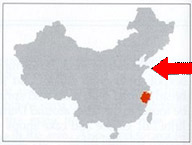Chinese Scientist Claim that Shandong Fossil Site is “World’s Largest”
The famous Shandong fossil site, potential the largest collection of dinosaur fossils in the world!
For China 2008 has been a memorable year, the economy has established itself as important contributor to global economic growth, and many Chinese banks now support the American financial institutions. The Beijing Olympic Games were an astonishing feat of organisation, London 2012 will do well to compare favourably to the Chinese efforts.
From a palaeontological point of view, Chinese researchers have continued to publish details of amazing fossil discoveries from around their vast country. Now the Chinese authorities are claiming that a dinosaur fossil field being excavated in eastern China could well represent the largest in the world.
Shandong Fossil Site
The site, located near Zhucheng City in the province of Shandong has yielded more than 7,600 fossils but many more will be found as the site is explored further. Many of the scientists studying the area are from the Institute of Vertebrate Palaeontology and Palaeoanthropology at Beijing. An institute, that was founded in 1957 and even though it is much younger than many of the museums in the west; it already boasts one of the biggest dinosaur and vertebrate fossil collections in the world. The collection is estimated to exceed over 200,000 vertebrate specimens, no doubt the number will be increased even further as material from Shandong is added.
The palaeontologist in charge of the dig sites at Shandong, Dr Zhao Xijin stated:
“The discoveries are expected to contribute to research on the mystery of the dinosaur extinction”.
This reflects the fact that the strata in the area was laid down at the end of the Age of Reptiles, during the Late Cretaceous. The majority of the major dinosaur fossils found to date represent members of the hadrosaur group (plant-eating dinosaurs). It is hoped that the Chinese discoveries will eventually rival those finds of duck-billed dinosaurs from North America.
Map of Showing Location of Shandong Province

Picture credit: Everything Dinosaur
The arrow in the picture indicates the location of Shandong Province on the eastern seaboard of China. The eastern part of the country is famous for fossil finds, indeed many of the provinces have their own Natural History museums, some of which have collections that are larger than the major Natural History museums in the United States.
The new fossil bed was discovered as the strata was explored by a mining company. One bed is estimated to be 300 metres long by 10 metres wide and approximately 5 metres deep. More than 3,000 fossils have been found at this one site alone, many of the fossils may represent new genera, the research team have claimed.
New Genera of Dinosaurs Discovered
New genera of ankylosaur, tyrannosaur and other theropods have been discovered and a 2-metre-long skull of an unknown species of ceratopsian (horned dinosaur like Triceratops) has been unearthed. This is the first discovery of such a large, horned dinosaur to be made in Asia.
It seems that this region in the Late Cretaceous was an ideal dinosaur habitat, with lush vegetation and plenty of lakes and rivers. In an attempt to explain the concentration of fossil remains scientists have speculated that a nearby volcano may have erupted that killed off many of the large animals in the area, and subsequent floods brought the fossils together into their final resting place.
Mining exploration has been suspended in the area, until better weather arrives in the spring, but local authorities are already commenting on the possibility of there being a fossil museum and park built on the site. This would reflect the importance of the location to the scientific community and a similar park has already been built in the central province of Szechuan at Dashanpu – the site of another dense dinosaur fossil bed, this time representing animals from the Middle Jurassic.
Everything Dinosaur works closely with a Chinese company (PNSO) to help create dinosaur and prehistoric animal models and replicas: PNSO Age of Dinosaurs Models.






Leave A Comment